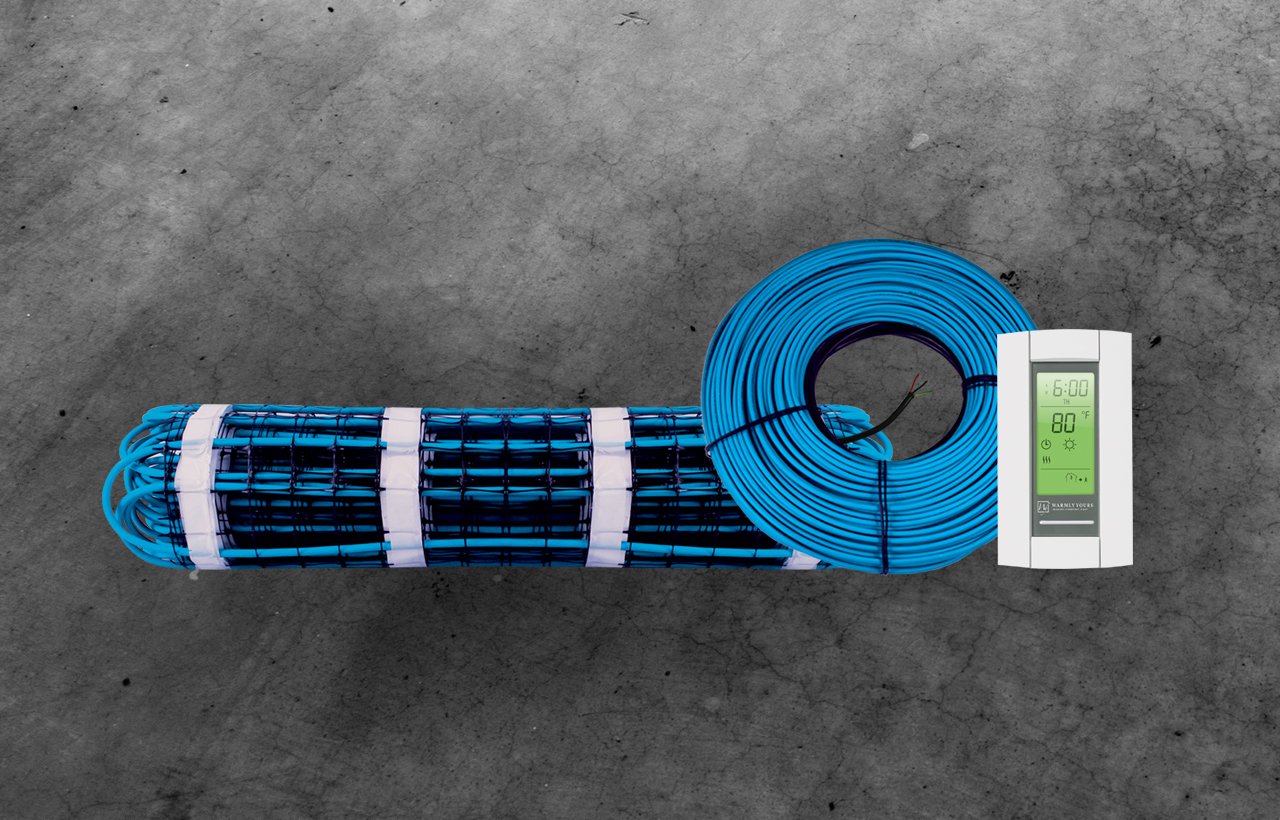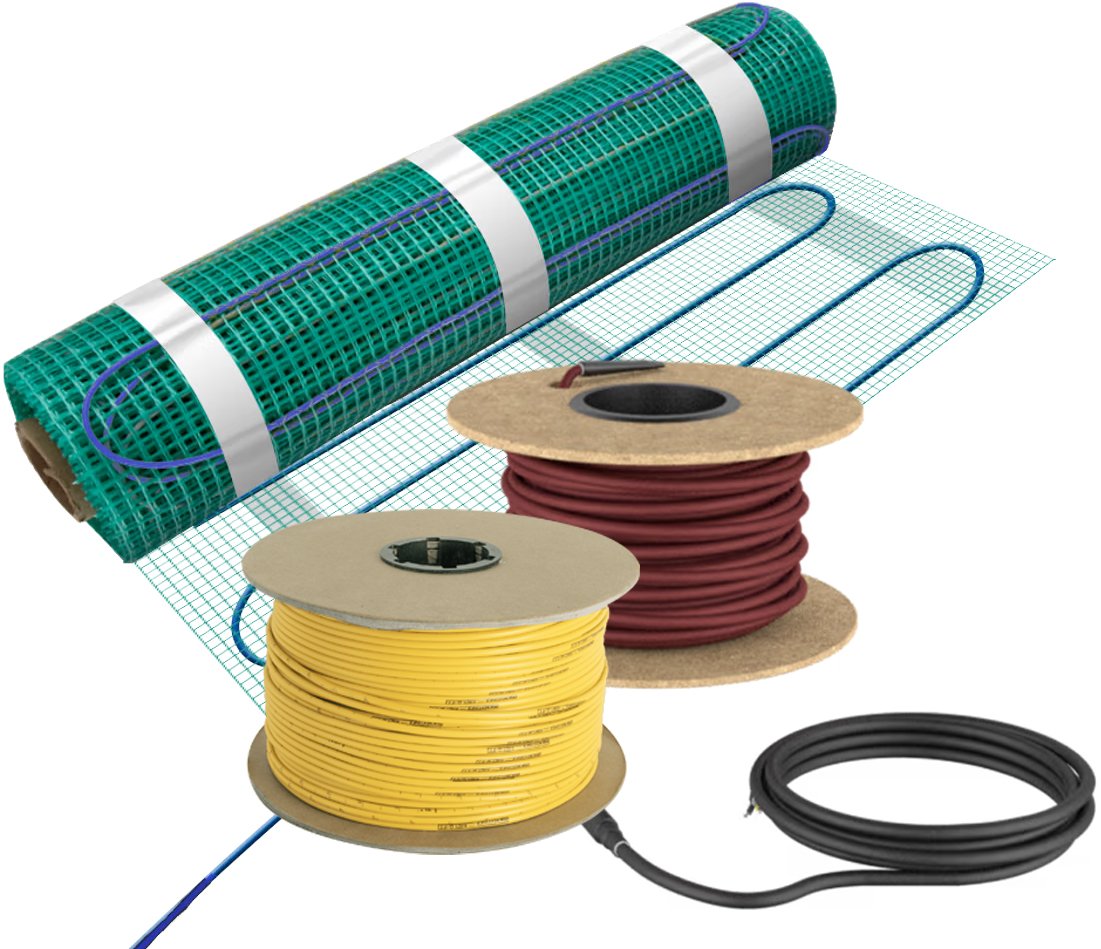
In This Article
- What Is a Concrete Slab Floor?
- How Will You Use the Room—and the Heat?
- In-Slab Heating: Best for New Construction or Additions
- Above-Slab Heating: Perfect for Renovations or Existing Homes
- Side-by-Side Comparison Table
- FAQs About Slab Heating and Radiant Floors
- Which Radiant Floor Heating System Is Right for You?
- Plan Your Heated Slab Project with Confidence
- Related Resources
Radiant floor heating is a powerful solution for making rooms built on concrete slabs warm, inviting, and energy-efficient. But whether you’re building new or renovating an existing space, the big question is: Should you install in-slab heating or a system above the slab? This guide will help you decide based on your project type, flooring material, and how you plan to use the room.
What Is a Concrete Slab Floor?
A concrete slab is a flat, horizontal structural element commonly used as the foundation for basements, garages, ground floors, and home additions. These floors tend to stay colder than other parts of the house—especially during winter—making them perfect candidates for radiant floor heating systems.
How Will You Use the Room—and the Heat?
The biggest factor in choosing between in-slab and above-slab heating is how you plan to use the space and what kind of heating performance you expect:
-
Short, scheduled heat (e.g., mornings and evenings): Choose TempZone™ Cable or Mats
-
Continuous warmth all day or night: Choose in-slab heating Cable or Mat
-
Polished or stamped concrete surface: Choose in-slab heating
In-Slab Heating: Best for New Construction or Additions
If you’re pouring a new concrete slab—whether for an addition, garage, or new home—in-slab heating is the most effective option. This system is embedded directly into the concrete as it’s poured, providing gradual but long-lasting radiant warmth.
Product Options:
-
Slab Heating Mats – Easy-to-install mesh-backed mats with pre-spaced cables
-
Slab Heating Cables – Flexible option for large or uniquely shaped areas
Wattage: 20 watts per square foot
Best For: Long-duration heating, new builds, and decorative concrete floors

Above-Slab Heating: Perfect for Renovations or Existing Homes
If your slab is already poured, an above-slab radiant system is your best bet. These systems are installed on top of the existing concrete, just below the final flooring layer.
TempZone™ Systems are perfect for:
Product Options:
-
TempZone™ Mats – Mesh-backed rolls with pre-spaced heating cables
-
TempZone™ Cable – A free-form option spaced at 3”, 4”, or 5”, depending on your heat needs and local climate conditions. Tighter spacing (3”) is recommended for colder regions where a faster and more intense heat output is required, while wider spacing (4”–5”) may be sufficient in milder climates.
Wattage: 15 watts per square foot
Best For: Quick warm-up, flexible schedules, retrofit applications

Note: For TempZone™ systems, always install a layer of ThermalSheet™ insulating underlayment to improve energy efficiency, heat distribution, and moisture resistance.
Side-by-Side Comparison Table
Feature |
In-Slab Heating |
Above-Slab Heating (TempZone™) |
|---|---|---|
Installation Method |
Embedded in freshly poured concrete |
Installed on top of existing slab |
Ideal Use Case |
New builds, additions, polished/stamped concrete |
Renovations, existing slab, tile/stone floors |
Heat-Up Speed |
Gradual, slow heat delivery |
Quick response, fast warm-up |
Daily Use Pattern |
Best for long, continuous use (all-day warmth) |
Ideal for scheduled heating (e.g., morning/evening) |
Wattage per Square Foot |
20 W/sq. ft. |
15 W/sq. ft. |
Product Formats |
Slab Heat Mats and Cables |
TempZone™ Mats and Cables |
Flooring Compatibility |
Concrete slab (no finish flooring needed) |
Tile, stone (with TempZone™), laminate/carpet (use Environ™) |
Recommended Underlayment |
Not required |
ThermalSheet™ recommended |
Cost Consideration |
Efficient for continuous, all-day heating—ideal for spaces that stay warm most of the time |
Energy-saving option for scheduled use—best for rooms used during specific hours like mornings or evenings. |
FAQs About Slab Heating and Radiant Floors
Wondering if slab heating is right for your project? Here are answers to common questions:
What is the best way to heat a concrete slab floor?
The most efficient method is to embed radiant heating cables or mats directly into the slab during the pour. This provides long-lasting, consistent warmth.
Can I install radiant heat over an existing concrete slab?
Yes. Above-slab systems like TempZone™ can be installed over existing concrete using underlayment and self-leveling cement, depending on your floor type.
How long does it take for a heated concrete slab to warm up?
In-slab systems take longer to warm up—typically several hours—due to the thermal mass of concrete. However, once warm, they hold heat efficiently.
Is radiant heating expensive to run?
Radiant heating can be very cost-effective, especially in well-insulated areas. In-slab systems are efficient for long-duration heating, while TempZone™ systems are ideal for scheduled or short-use heating.
Which Radiant Floor Heating System Is Right for You?
Still unsure? Here’s a quick guide:
-
Choose Slab Heating if you’re building new and want a seamless, built-in system that delivers consistent heat throughout the day.
-
Choose TempZone™ if you’re renovating or want a responsive system that works with your schedule and provides faster heat-up times.
Plan Your Heated Slab Project with Confidence
Whether you’re transforming a basement, garage, or the entire first floor, radiant heat is one of the most effective ways to eliminate cold spots and boost comfort. But choosing the right system—based on your slab type, flooring, and daily use—makes all the difference.
Need help deciding? Submit your floor plan to get a free SmartPlan™, which includes:
-
A custom layout for your project
-
A detailed electrical plan
-
A complete materials list
-
Expert recommendations based on your goals
Let us help you bring lasting warmth to your concrete slab—simply, efficiently, and with confidence.
Related Resources
-
Radiant Heating Guide – Understand how radiant heat works in different floor types
-
ThermalSheet Insulating Underlayment – Recommended for TempZone™ installs
-
Installation Support Hub – Manuals, videos, FAQs, and more
-
Floor Plan Gallery – See how other customers installed radiant floor heat
-
Get an Instant Quote – Estimate the cost of your heated floor project
Have Questions About Your Project?
Our team of Radiant Experts is ready to help!
Comments
Stay Updated
Get the latest radiant heating news and tips delivered to your inbox.




I have a floating vinyl installed on concrete can I treat the vinyl as under layment then install a heat mat on top of the vinyl then add either carpet or some kind of a floating wood floor?
We do not recommend installing a floor heating system on top of a floating vinyl floor. The best course of action would be to pull up the existing floor covering and then install a floor heating system along with an insulating underlayment over the concrete slab (but underneath the floor heating system and the floor covering). This will also save you from adding unnecessary floor height to your installation. Hope that helps!
I have a lounge concrete floor with underlay & carpet on top and I would like to increase floor warmth without increasing the floor height too much. ??
You could definitely install electric floor heating under carpet (U.S. only) but over a proper insulating underlayment (we generally recommend either CeraZorb or Cork) and you'll only increase your floor height by the thickness of the heating element (our Environ Flex Roll is about 1/16th" thick) and the difference, if any, between the thickness of your existing underlay and a proper insulating underlayment (our CeraZorb is less than 1/4" thick). Hope that helps but if you have any further questions, please don't hesitate to give us a call at 1-800-875-5285!
Don’t know how exactly to explain this, but l will try. The electric heater used to heat up the concrete garage underground no longer works. Nothing under the concrete floor is broken so no digging is required. I need a heater only, but was given a very high estimate to replace. My husband when alive once used a wood stove heater which worked excellent, however we no longer had access to wood. So he went to electric. Any suggestions what is cost effective, works well, and energy efficient. The garage is uninsulated, made of concrete and is about 22x24? Thank you.
We would probably need more information to give you a solid answer but from the information you've provided, one option would be an infrared radiant panel: https://www.warmlyyours.com/radiant-heat-panels They can help provide supplemental heat to spaces without having to replace the floor but it might not be enough heat output for the uninsulated room you've described. Hope that helps but if you have any further questions, please don't hesitate to give us a call at 1-800-875-5285.